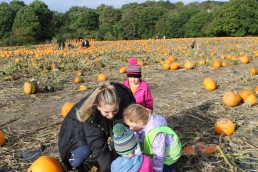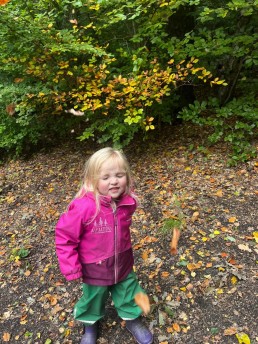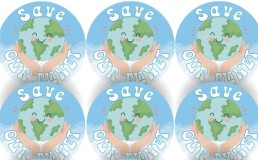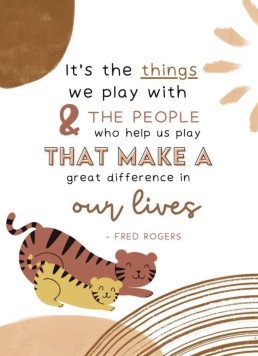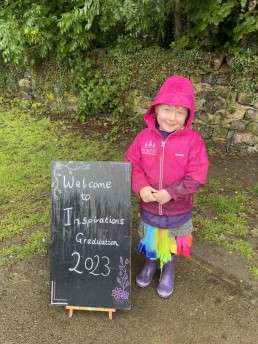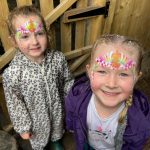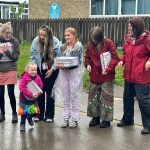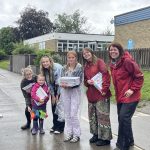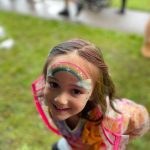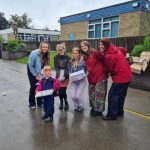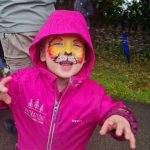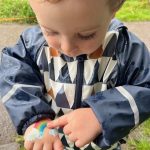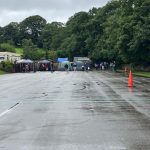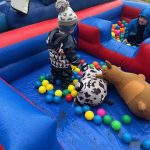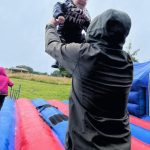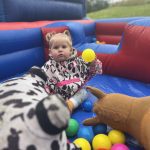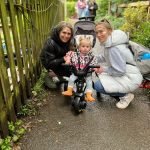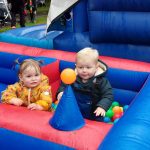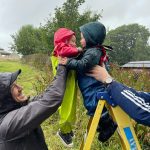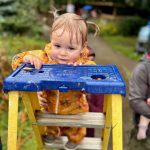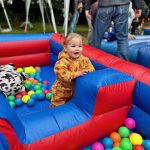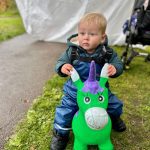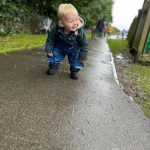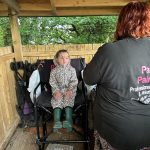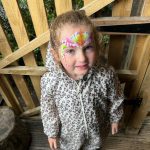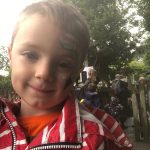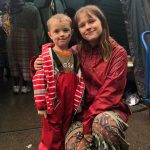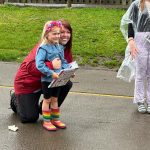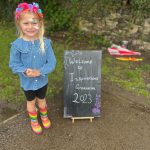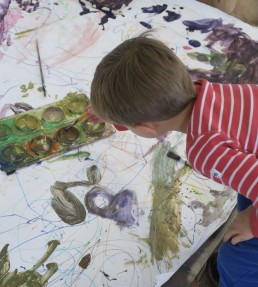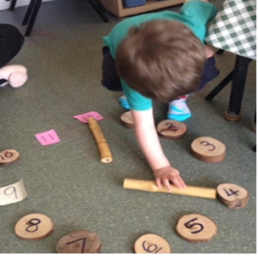Nursery Bag- What to Pack?
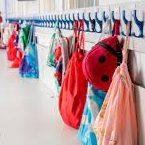
Up until now the only baby bag you've needed is your maternity bag filled with nappies, snacks and one of everything to cover all eventualities. But when it comes to starting nursery your baby will need their own bag to bring with them each day. It's that first possession that belongs to them, the start of being independent. So let's make this transition as easy as possible and give you a check list to make sure you're not forgetting anything in that all important nursery bag.
What to pack?
Every room requires something a little different, and we know there can be a lot to remember so here's a broken down list of everything you'll need in your child's nursery bag for each room.
Our Baby Rooms- Hedgehogs and Butterflies
- Bottle and Formula (we provide milk from 1 year old)
- Comforter e.g Dummy
- Sleep Sack (if needed)
- Waterproof coat or suit suitable for all conditions (We do have some waterproof trousers but for none walkers in particular padded suits are ideal)
- At least 2 sets of spare clothes and socks
- Spare bibs
- Appropriate/supportive footwear
- Wellies
Our Toddler Room- Honeybees
- At least 2 sets of spare clothes and socks
- A warm waterproof coat
- Water bottle
- Waterproof Trousers
- Wellies
- Spare Hat and Gloves
Our Pre-School Room- Ladybirds
- A water Bottle
- At least 2 spares of every item of clothing and socks
- Thick warm socks for Forest School
- Wellies
'Take care of the little things and the big things fall into place'.
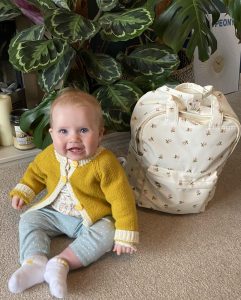
Harvesting Memories: Pumpkin Picking
History
Inspirations day out
On Wednesday the 18th of October, the preschool children begun their pumpkin adventure! The day consisted of a tractor ride, wheelbarrows, blue and pink pumpkin pickings and examining the squashed pumpkins. Throughout the day the children explored their curiosity into pumpkins asking questions about their shape, size, colour and texture, following their interest and enhancing their language.
Importance
Their are many impotence's to pumpkin picking for children, here are a few key points:
Activities
The Golden Season
Importance of autumn:
1. Sensory Stimulation: The sights, sounds, smells, and textures of autumn engage children's senses, fostering sensory development and awareness. From the vibrant colours of falling leaves to the crispness of the air, these experiences help children refine their senses and make meaningful connections with the world around them.
What we do:
Buzzing with Bees
In this blog, we'll explore why bees are so important for our environment and why it's great for children to learn about them.
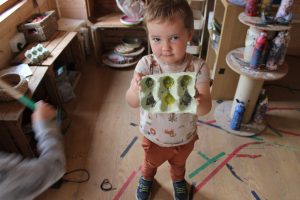
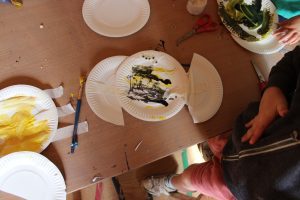
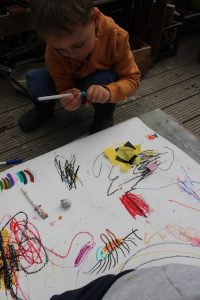
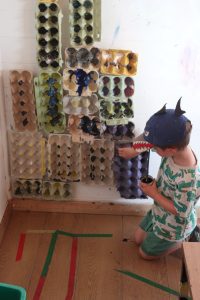
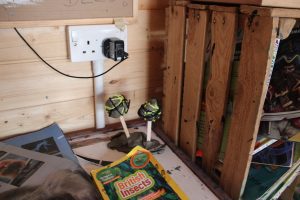
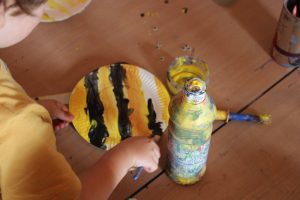
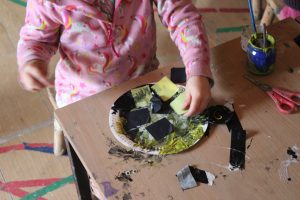

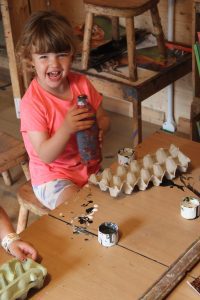
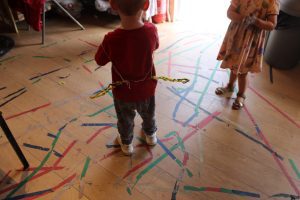
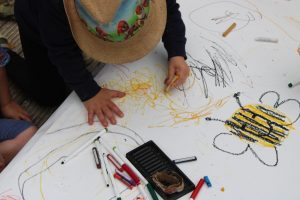

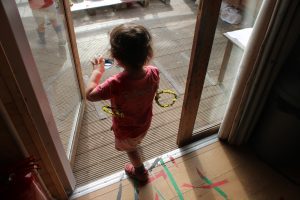
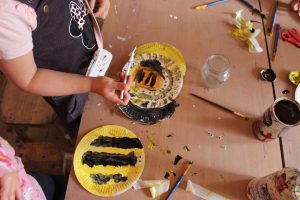
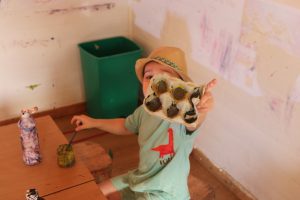
What are bees?
Bees are essential pollinators that help plants grow and produce the food we eat. Teaching children about bees can foster a love for nature, encourage environmental stewardship, and inspire curiosity about the natural world. From honeybees to bumblebees, carpenter bees to sweat bees, there's a wide variety of bees out there, each with its own unique characteristics and roles in the ecosystem. Bees have different roles within their colonies. The queen bee lays eggs and leads the hive, while worker bees gather nectar, make honey, and care for the colony. Male bees, called drones, mate with the queen. Each role is essential for the survival of the hive! This is what the children have been exploring through different materials and with lots of imagination!
The first interest in bees happened when one kind bee came to visit us in the art studio and stayed with us throughout the session.
Children's quotes:
"Is the bee our friend?"
"Did you ask the bee to come visit the art studio?"
" Has the pesky pirate brought the bee here?"
The project:
Therefore, the interest blossomed into a 4 week project. In the art studio, the children were buzzing with excitement as they dived into the world of bees. They used their creative skills to construct intricate bee hives out of kindly donated recycled egg cartons, adding pops of colour and intricate details to make them come alive. With clay and other loose parts, they sculpted their own unique bees, paying attention to details like wings, stripes, and fuzzy textures.
The children also incorporated role play into their bee exploration. They used their crafted bee wings to buzz around, immersing themselves in the world of bees. They even invented a game called "Sting," where they pretended to be busy bees collecting nectar and avoiding obstacles and of course stinging their friends and Art Studio Jess ! It was a way for them to engage their imaginations, develop social skills, and deepen their understanding of bees through interactive play. The art studio truly became a hive of creativity and fun!
How to help the bees:
Here are some ways in which we can all help Bees thrive in our world the way they help us thrive too!
1. Plant a Bee-Friendly Garden: Get your hands dirty and create a buzzing paradise by planting flowers, herbs, and shrubs that attract bees. Sunflowers, lavender, and wildflowers are just a few examples of bee-friendly plants that can provide a nutritious food source for these important pollinators.
2. Build Bee Hotels: Help provide shelter for solitary bees by constructing bee hotels. These can be made from simple materials like bamboo or drilled wooden blocks. Hang them in your garden to offer nesting sites for these beneficial insects.
3. Avoid Pesticides: Teach children about the harmful effects of pesticides on bees and encourage them to choose natural alternatives for pest control in the garden. This way, we can create a safe environment for bees to thrive.
4. Learn About Beekeeping: If you have the space and resources, consider exploring the fascinating world of beekeeping with your children. It's a hands-on experience that allows them to learn about the life cycle of bees, the importance of honey production, and the role of beekeepers in supporting bee populations.
5. Spread Awareness on the fascinating things that Bees do!
By involving our children in these activities, we not only help bees thrive but also foster a deeper appreciation for nature and the environment. Together, we can make a positive impact on bee populations and create a brighter future for these incredible creatures
In conclusion, the art studio became a vibrant space where children explored the vibrant colours and patterns of bees, learning about their importance in the environment while having fun with art. It's a delightful way for children to connect with nature and foster their artistic talents!
Jess Snaddon.
The Importance of Litter Picking in Early Years
In early years, fostering a clean and safe environment is crucial for the well-being and development
of young children. One effective way to instil a sense of responsibility and environmental
consciousness is through litter picking activities. As a community, Horsforth have a litter picking
group that dedicates time to cleaning the neighbourhood. At Inspirations, we try to get involved with
the community and litter picking is something we are passionate about. The children in our
preschool get involved quite frequently with our forest school practitioners.
In this blog, we will explore the significance of litter picking in early years and how it benefits both
children and the community.
1. Promoting Environmental Awareness:
Litter picking introduces children to the concept of environmental responsibility from an early age.
By engaging in hands-on activities, such as picking up litter, children develop an understanding of the
impact of their actions on the environment. They learn that their small efforts can make a big
difference in keeping their surroundings clean and preserving nature.
2. Encouraging Physical Activity:
Litter picking is not only beneficial for the environment but also for the physical development of
children. It provides an opportunity for them to engage in physical activity, promoting gross motor
skills and coordination. Walking, bending, and reaching to pick up litter helps children develop their
muscles and improve their overall fitness levels.
3. Developing Fine Motor Skills:
Litter picking involves picking up small objects, which helps children refine their fine motor skills. The
act of grasping and manipulating different types of litter, such as paper, plastic, or leaves, enhances
their hand-eye coordination and dexterity. These skills are essential for various tasks, including
writing, drawing, and self-care activities.
4. Teaching Responsibility and Empathy:
Engaging in litter picking activities teaches children about responsibility and empathy towards their
environment and community. They learn that they have a role to play in maintaining cleanliness and
taking care of their surroundings. By understanding the consequences of littering, children develop
empathy towards the environment and the impact it has on others.
5. Encouraging Teamwork and Cooperation:
Litter picking can be done as a group activity, fostering teamwork and cooperation among children.
Working together to achieve a common goal promotes social skills, communication, and
collaboration. Children learn to take turns, share responsibilities, and support each other, creating a
sense of unity and belonging within the group.
6. Connecting with Nature:
Litter picking provides an opportunity for children to connect with nature and explore their
surroundings. As they engage in the activity, they may discover different types of plants, insects, or
animals. This hands-on experience helps them develop a sense of curiosity and appreciation for the
natural world, fostering a lifelong love for the environment. Exploring our natural surroundings is a focus of ours at Inspirations and we feel passionate in doing so. Our pre-schoolers have the option to
explore the stunning Hunger hills woods twice a day. We are very lucky that the nursery is situated
in a location with beautiful surroundings with lots of nature for us to explore.
7. Building a Sense of Pride:
When children actively participate in litter picking, they develop a sense of pride in their
accomplishments. Seeing the positive impact of their efforts, such as a cleaner and tidier
environment, boosts their self-esteem and confidence. This sense of pride motivates them to
continue engaging in responsible behaviours and taking care of their surroundings.
In conclusion, litter picking in early years childcare is a valuable activity that promotes environmental awareness, physical development, responsibility, empathy, teamwork, and a connection with nature. By
incorporating litter picking into the curriculum, educators can instil lifelong values of cleanliness and
environmental stewardship in young children. We will also be getting involved in the community
composting project in Drury fields. This will support us in educating the children about the world and
helping to keep us cleaner. Help us encourage the next generation to be responsible citizens who
actively contribute to a cleaner and healthier world.
|
Nurturing Imagination and Creativity
In today’s fast-paced world, where structured learning and organized activities often take centre stage in a child’s life, the value of unstructured, child-led play is sometimes underestimated. The Reggio Emilia approach, an innovative educational philosophy that originated in the town of Reggio Emilia, Italy, places a profound emphasis on the significance of child-led play in early childhood education. In this blog, we’ll explore the importance of child-led play and how it aligns with the principles of the Reggio Emilia approach.
Understanding Child-Led Play
Child-led play, often referred to as free play or unstructured play, is a type of play where children take the lead in choosing what to do, how to do it, and for how long. It occurs when children engage in activities driven by their interests, imagination, and curiosity, rather than following adult-directed instructions. This type of play can involve activities like building with blocks, creating art, exploring nature, or pretending to be characters in imaginative scenarios.
The Reggio Emilia Approach
The Reggio Emilia approach to early childhood education is renowned for its unique perspective on child development and learning. Developed by Loris Malaguzzi in post-World War II Italy, this approach is deeply rooted in the belief that children are capable, curious, and rich in potential. It recognizes that children have their own unique ways of understanding and making sense of the world, and this understanding is a cornerstone of the Reggio Emilia philosophy.
Child-Led Play in the Reggio Emilia Approach
1. **Respect for Children’s Autonomy**: Child-led play is at the heart of the Reggio Emilia approach. Educators in Reggio Emilia schools observe and listen to children carefully, allowing them to express their thoughts, ideas, and interests. This approach respects and values the autonomy of the child.
2. **Emergent Curriculum**: In Reggio Emilia-inspired classrooms, the curriculum is often emergent, meaning it evolves based on the children’s interests and inquiries. Child-led play provides a natural platform for educators to identify these interests and build educational experiences around them.
3. **Nurturing Creativity and Problem-Solving**: Unstructured play fosters creativity and problem-solving skills. When children engage in activities they are passionate about, they are more likely to encounter challenges that require them to think critically and find solutions independently.
4. **Documentation and Reflection**: Reggio Emilia educators document children’s play and learning experiences. This documentation is used for reflection, assessment, and to guide future learning opportunities. Child-led play provides rich content for this documentation.
5. **Collaboration and Social Skills**: Child-led play often involves interaction with peers. Through these interactions, children learn important social skills, such as communication, negotiation, and teamwork.
6. **Environmental Education**: Reggio Emilia-inspired schools often incorporate the natural environment into play. Children are encouraged to explore and connect with nature, fostering a sense of environmental stewardship from an early age.
Child-led play is not merely a leisure activity but a powerful educational tool that aligns seamlessly with the principles of the Reggio Emilia approach. It respects children as competent learners, encourages their creativity, and cultivates a lifelong love for learning. By allowing children to take the lead in their play, we are nurturing the seeds of curiosity, independence, and a deeper understanding of the world around them. In essence, child-led play, as championed by the Reggio Emilia approach, is an investment in a brighter, more imaginative future for our children.
Summer Party
Rain or shine, its party time !!!
Although the weather decided to change its tune, all of us at Inspirations loved this years summer party.
We had 32 school leavers this year, who all dedicated a song to their families and friends called ''I'm ready to go'', and we all had a tear in our eyes. There was also an amazing face painter who joined in on the fun named Paula Paintpot who has a small business in Horsforth. Alongside all of that, there was a soft play an bouncy castle for the children to enjoy and lots of gazebos due to the weather, where activities took place in such as bubble and book mark making, facilitated by members of staff from Inspirations. All the food and drink was provided by Inspirations and by the end there wasn't even a cucumber left!
We are all so thankful for everyone who came and enjoyed this fun filled day with us, we cannot wait for next year and to all the children moving on to a new beginning, we will miss you all and wish you the all the best.
Reduce Reuse Recycle

Welcome to our Inspirations Eco- school blog.
We can’t wait to share all our activities and eco-projects that will be happening in our setting.
The Early Years is a crucial time to install a love and respect for the environment in our children and
we are so lucky at Inspirations to have the perfect environment to do this. We are committed to
providing our children with a green and sustainable education.
Our Forest School is offered all year round as part of our daily pre-school activities. Between these
off-site sessions forest school activities take place on site around our veg garden, wildlife pond and
within our extensive grounds. We have implemented various eco-friendly practices to reduce our carbon footprint by encouraging reusable water bottles, recycling paper, taking part in this year’s Big Battery Hunt, and even making our own paper!
Our outdoor area is a nature inspired learning space. Our children have enjoyed making bug hotels
to provide a safe hideaway for wildlife. Our well-built hotels can shelter anything from hedgehogs to
toads, solitary bees to bumblebees, ladybirds to woodlice.
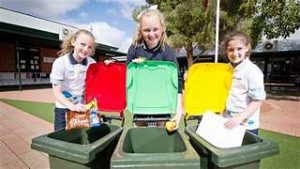
We also participated in Plant life's annual campaign No Mow May. Educating our children on the
importance of boosting flowers, and nectar, available to pollinating insects such as bees, butterflies,
and moths. This then also allows spring flowers to set seed and plants to establish themselves in
advance of the summer.
At Inspirations we believe that by introducing eco-friendly and environmental education at an early
age, we are nurturing a generation of responsible and environmentally conscious citizens. Our vision is that all our children grow up with an understanding of the impact their actions have on the planet and are developing a sense of responsibility towards it.
We are so excited to be starting our eco-school journey in the new academic year, working towards
our first Eco-Schools Green Flag. We also have a community project that we are so excited to get
involved with and can’t wait to share with you.
Together, we can make and create a greener and more sustainable future.
Tara Slade.
Embracing the process
Personal growth through art
Children’s art can provoke many reactions but there is so much more going on 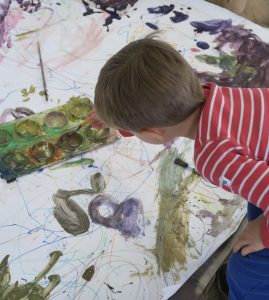 under the surface than what can be seen. Art allows children to reconstruct and assimilate their experiences and observations, to create meaning to the world around them. Especially for those who are just beginning to learn how to read and write, as shapes and symbols become a communication tool and a personal language.
under the surface than what can be seen. Art allows children to reconstruct and assimilate their experiences and observations, to create meaning to the world around them. Especially for those who are just beginning to learn how to read and write, as shapes and symbols become a communication tool and a personal language.
Adults often judge children’s art by adult standards, assessing it on its execution. However what a child creates is a unique representation of their own experiences and development. Children are able to produce artwork with distinctive qualities that no adult can replicate.
Journey of discovery
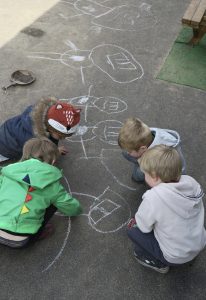 Children are often shown the ‘right’ way when learning numbers and letters, whereas art opens up a world of possibilities where diversity and individuality can be celebrated. There may be a temptation for educators to fix, provide templates or insist all children follow the same objective. But this extinguishes the activation of creativity and invention, whilst subconsciously enforcing the notion that there is a ‘right’ way to do art.
Children are often shown the ‘right’ way when learning numbers and letters, whereas art opens up a world of possibilities where diversity and individuality can be celebrated. There may be a temptation for educators to fix, provide templates or insist all children follow the same objective. But this extinguishes the activation of creativity and invention, whilst subconsciously enforcing the notion that there is a ‘right’ way to do art.
In contrast, the Reggio Emilia approach we implement at Inspirations allows children to explore new materials and mediums by themselves, for themselves. Keeping the environment and activity open-ended provides children the freedom and responsibility to make their own decisions. Materials are thoroughly explored, skills and knowledge are repeated and reinforced in their own time, and children become masters of their own learning. Children can put in to practice the ‘hundred languages’, communicating, expressing and creating a dialogue of their own... one which is rich and colourful and not limited to an adult’s expectation.
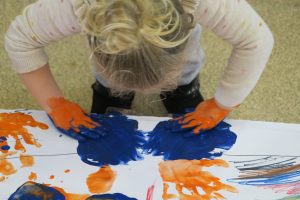 The process of a creation is equally a process for the child. Simple scribbles can be a representation of an object in action or an experiment on pressure and shape. Figures and shapes can become parts of a narrative that slowly emerge. Therefore, when a child is put at the centre of their learning they feel empowered and encouraged to fully immerse themselves in their process rather than fixating on the outcome. Ideas of right and wrong fade away and curiosity and discovery take precedence. Ultimately, providing the child harmony between body and soul, deepening their connection emotional, cognitively and physically to their sense of self.
The process of a creation is equally a process for the child. Simple scribbles can be a representation of an object in action or an experiment on pressure and shape. Figures and shapes can become parts of a narrative that slowly emerge. Therefore, when a child is put at the centre of their learning they feel empowered and encouraged to fully immerse themselves in their process rather than fixating on the outcome. Ideas of right and wrong fade away and curiosity and discovery take precedence. Ultimately, providing the child harmony between body and soul, deepening their connection emotional, cognitively and physically to their sense of self.
Julia Lai
Pre-school Maths
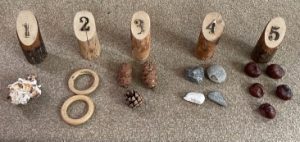
Mathematical development is complex. Developing a secure grasp of early mathematical ideas takes time. Even if a child appears to be engaging successfully in mathematical activities, such as reciting the count sequence, they may not understand the meaning of the numbers they are saying. It is important that practitioners are aware of typical development of mathematical skills and concepts and have the knowledge to support children’s understanding.
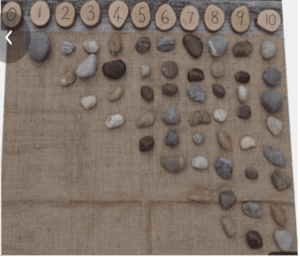 We at Inspirations have observed how beneficial the use of loose parts is for maths development. When children transform objects in their creative play, they are unknowingly problem-solving and building their imaginations. For example, when sticks and stones become food, mathematical concepts are natural encouraged as they assess the shapes, sizes and amounts they need. Often children will simply use loose parts to line up, order in size, number and make patterns.
We at Inspirations have observed how beneficial the use of loose parts is for maths development. When children transform objects in their creative play, they are unknowingly problem-solving and building their imaginations. For example, when sticks and stones become food, mathematical concepts are natural encouraged as they assess the shapes, sizes and amounts they need. Often children will simply use loose parts to line up, order in size, number and make patterns.
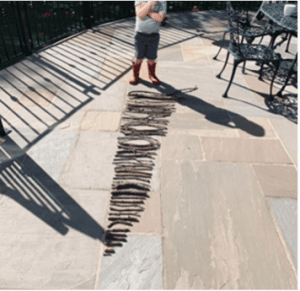 Pattern is extremely important for maths development. Recognising number through pattern and subitising (instantly recognising without counting) are skills we can help to develop by using a wide range of ideas and resources. Children will quickly recognise what the patterns on dice represent as numbers and progress to adding two sets of number patterns through board games and play.
Pattern is extremely important for maths development. Recognising number through pattern and subitising (instantly recognising without counting) are skills we can help to develop by using a wide range of ideas and resources. Children will quickly recognise what the patterns on dice represent as numbers and progress to adding two sets of number patterns through board games and play.
Dots seen in a regular pattern representing numbers has been used to support addition and subtraction in schools for many years.
. . .
. . = 7 . . = 3
. .
.
Eventually children become familiar with each number representation as they see these same patterns while recognising the shapes they make.
Numicon uses familiar shapes to represent numbers. Exploration of these resources at a young age will familiarise a child with their shapes and colours and eventually numbers will be assigned to each shape. As the shapes are 1-10 they can be used for ‘number bonds to ten’ by fitting the shapes together to form the 10th shape. They can also be used to support ‘adding beyond 10’ or ordering them as numbers and matching the numerals.
![]()
Conceptualising number through pattern can be supported in many other ways such as playing dominoes, using dice in a board game, playing cards or using tens frames.
 Challenges and activities to support maths progression can be planned regularly with adult support. Practitioners can work with children, sensitively intervening with questioning and prompts. Metacognition is the ability to reflect on your own thinking processes. Practitioners should encourage children to explain their thinking and strategies when solving mathematical problems. This enables children to gain an insight into their own thinking, learn from their mistakes, and develop problem-solving skills. Questions such as, ‘How did you…?’, ‘Why does this…?’, encourages children to reflect more deeply and to put their thought processes into words. Our practitioners seize chances to reinforce mathematical vocabulary in everyday situations. For example, by commenting on which child is standing ‘first’, ‘second’, or ‘last’ in line, which child has ‘more than’ or ‘fewer’ objects than another child and how many steps it takes to climb the stairs. The introduction of more refined mathematical vocabulary is then slowly increased through focused activities.
Challenges and activities to support maths progression can be planned regularly with adult support. Practitioners can work with children, sensitively intervening with questioning and prompts. Metacognition is the ability to reflect on your own thinking processes. Practitioners should encourage children to explain their thinking and strategies when solving mathematical problems. This enables children to gain an insight into their own thinking, learn from their mistakes, and develop problem-solving skills. Questions such as, ‘How did you…?’, ‘Why does this…?’, encourages children to reflect more deeply and to put their thought processes into words. Our practitioners seize chances to reinforce mathematical vocabulary in everyday situations. For example, by commenting on which child is standing ‘first’, ‘second’, or ‘last’ in line, which child has ‘more than’ or ‘fewer’ objects than another child and how many steps it takes to climb the stairs. The introduction of more refined mathematical vocabulary is then slowly increased through focused activities.
 Physical whole-body movement and gestures support the learning of mathematics, for example, moving along a physical number line or jumping and clapping while counting. Practitioners should also encourage children’s use of fingers which are important manipulatives, initially useful for supporting counting and later for counting in groups.
Physical whole-body movement and gestures support the learning of mathematics, for example, moving along a physical number line or jumping and clapping while counting. Practitioners should also encourage children’s use of fingers which are important manipulatives, initially useful for supporting counting and later for counting in groups.
It is important to realise that not all maths activities need specific or specialised resources, anything can be counted and numbers can be formed with most materials. During Covid lockdown, Inspirations provided a virtual nursery and the first activity we suggested was to go for a walk and collect natural resources. These were then used in our future activities to ensure that all children could take part without having to purchase anything.
Maths opportunities are all around us. We should encourage learning in this area through numerical songs, games, activities and play, to help children develop a keen attitude for maths, so they can follow this interest when it becomes a lot trickier in formal school!
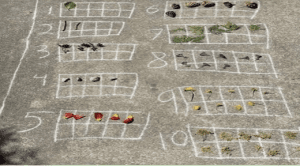
Deborah Keane
